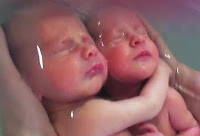
Newcomers to Buddhism are usually impressed by the clarity, directness, and earthy practicality of the Dharma (the Buddha's Teaching) as embodied in such basic teachings as the
- Four Noble Truths
- Noble Eightfold Path
- Threefold Training.
These clear as day teachings are accessible to any serious spiritual seeker looking for a way beyond suffering.
 |
| I don't want let go, but rebirth separates us. |
At this point, they suspect that the Teaching has swerved off course, tumbling from the grand highway of reason into wistfulness and speculation.
- The problem in Buddhism is samsara. The solution is moksha. These are rebirth (always intrinsically bound up with disappointment and suffering) and liberation from rebirth (which means the end of all suffering). Ordinarily, beings fail to understand death, which is called "death" because we are incessantly reborn according to our karma, good and ill. So they fail to understand liberation, nirvana.
Even modernist interpreters of Buddhism seem to have trouble taking rebirth seriously. Some dismiss it as just a piece of cultural baggage, "ancient Indian metaphysics," which the Buddha retained in deference to the world view of his age.
Others interpret it as a metaphor for the change of mental states, with the realms of rebirth seen as symbols for psychological archetypes. A few critics even question the authenticity of the texts on rebirth, arguing that they must be interpolations inserted sometime later.
 |
| Is death final or is there more? There is more, much more. It's called samsara. |
A quick glance at the Pali language sutras or "discourses" would show that none of these claims has substance.
The teachings on rebirth crop up almost everywhere in the canon and are so closely bound to a host of other doctrines that to remove it would virtually reduce the Dharma to tatters.
Moreover, when the sutras speak of rebirth into the five realms — the hell states, the animal world, the spirit realm, the human world, and the heavens — they never hint that these terms are meant symbolically.
 |
| We are reborn again and again and again... |
Here I will not be arguing the case for the scientific validity of rebirth. (For that scientific evidence, see below at the work of Dr. Ian Stevenson, MD, University of Virginia).
Instead, I want to show that the idea of rebirth makes sense. It makes sense in two ways -- in that it is intelligible, having meaning both intrinsically and in relation to the Dharma as a whole, and in that it helps us make sense of and understand our place in the world.
This can be established in relation to three philosophical domains of discourse: the ethical, ontological, and soteriological. More
Forget Philosophy. Let's ask Science
 Ian Stevenson (1918-2007) was a psychiatrist who worked for the University of Virginia School of Medicine for 50 years and was:
Ian Stevenson (1918-2007) was a psychiatrist who worked for the University of Virginia School of Medicine for 50 years and was:
Forget Philosophy. Let's ask Science
 Ian Stevenson (1918-2007) was a psychiatrist who worked for the University of Virginia School of Medicine for 50 years and was:
Ian Stevenson (1918-2007) was a psychiatrist who worked for the University of Virginia School of Medicine for 50 years and was:- chair of the Department of Psychiatry from 1957 to 1967
- Carlson professor of psychiatry from 1967 to 2001
- research professor of psychiatry from 2002 until his rebirth (whereabouts unknown)
- founder and director of the University of Virginia's Division of Perceptual Studies investigating parapsychological phenomena such as (1) reincarnation, (2) near-death experiences, (3) out-of-body experiences, (4) after-death communications, (5) deathbed visions, (6) altered states of consciousness and psi
internationally recognized for research into reincarnation by discovering evidence suggesting that memories and physical injuries can be transferred from one lifetime to another
Nick, I think it's possible. - Al, I'm sure it is. - traveled extensively over a period of 40 years
- investigated 3,000 cases of children around the world who recalled having past lives
- presented meticulously researched evidence that such children had unusual abilities, illnesses, phobias, and philias that cannot be explained by the environment or heredity:
- Introduction to Dr. Ian Stevenson's Research
- The Five Common Characteristics in Most of Dr. Stevenson's Study
- Birthmarks and Birth Defects Corresponding to Wounds on Deceased Persons
- Correspondences Between Wounds and Birthmarks
- Cases with Two or More Birthmarks
- Examples of Other Correspondences of Detail between Wounds and Birthmarks
- Three Examples of Birth Defects
- Discussion
- Acknowledgements
- References
- Articles on Reincarnation by Researchers of the Division of Perceptual Studies


No comments:
Post a Comment